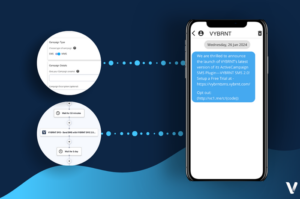Become more than just an online store, with Marketing Automation.
Here’s how an eCommerce company can effectively implement marketing automation technology and a CRM system, becoming more than just an online-store.
This post was contributed by Tim Preston of VYBRNT MarTech.
Selling online has evolved greatly over the last decade. With more and more competitors coming online all the time, it’s more important than ever to engage your core customer base and keep them as your customer! Research shows that 58% of online shoppers stop buying from a brand because of poor customers experience. This problem can greatly be addressed with a personalised, automated communication strategy.
With the benefit of a powerful CRM system (Customer Relationship Management) your customer engagement opportunities are limitless, and it’s critical that your business chooses a CRM with careful consideration. Most importantly, you want one with a powerful marketing automation component to it. You want to ensure your reach and message can be maximised to its full extent, providing an optimal customer experience.
First we will discuss in greater detail why a CRM is so important. Next we will conduct a competitor comparison of which CRM/MarTech tool is right for you. We also provide some info on how to get started implementing a system, if you haven’t already.
1. So why combine a CRM system with your online store?
In short, more money and more customers for your business. In this article we will walk you through how to jump ahead of the competition, and create a far more engaging brand than the status quo.
Average purchase conversion rates on an eCommerce store are approximately 2.86%. So what becomes of the 97.14% that leave the site without making a purchase? They leave, and may never come back. It’s important to understand that many visitors are at the beginning of their buying journey when they visit your website for the first time. And rather than propose marriage on the first date, you could provide valuable content about your offering. So instead of direct-to-purchase at a low conversion rate. It is likely more optimatel to go for data-capture, nurture, purchase, at a much higher conversion rate. In order to achieve this, you will need a top of funnel data capture strategy, backed by a Marketing Automation system! eCommerce strategy is evolving to embrace more customer nurturing and personalisation. A CRM is the mechanism that allows this to happen. The companies that are successful at both converting an initial sale, and also capturing data for the non-purchasers, are the ones winning the game.
Before implementing a data capture strategy, you’ll want to know your ideal customers’ pain points and have a deep understanding of what your customers need, when they need it, and what messaging will land with them. From there, you can provide some valuable content in exchange for their email or mobile number. We call this a ‘lead magnet’ strategy.
For example, a busy father looking for a household cleaning product online may benefit from your product, but might not be ready to purchase. So instead, help solve his problem with a downloadable guide or video on ‘how to clean your house in half the amount of time”. This will be a far more engaging marketing strategy than the competitors that are just showing the products to buy.
Once the prospect is in the database, they can be nurtured with more valuable content. At some point in their journey, they will have the trust to buy, and potentially be a customer for life.
So now let’s look at how this can be implemented.
2. Compose a lead magnet strategy
Create a lead magnet, that is backed by an automated email welcome sequence. Think of a simple, yet valuable free guide that is based on the core mission of your business. If you sell car accessories, provide an introductory free piece of content that discusses “Which car accessories every passionate owner must have, and which ones you should avoid!”. From there, those that by will enter your system as a ‘marketing qualified’ prospect. The nurture sequence will be designed to get them to purchase a bit further down the funnel, ideally on email 2 or 3. And if they don’t purchase then, you can start to drip a coupon offer. It’s a much more sophisticated approach to how you engage your audience.
Now of course, if they decide to purchase straigh away, they will also enter the CRM system. Even though they have already purchased, you can use the same system to cross-sell, up-sell and increase customer lifetime value.
So let’s look at which pieces of technology do this the best for eCommerce companies.
Add an image
1. ActiveCampaign
Add AC logo
In summary ActiveCampaign does it all. It gained global recognition over the last 5 years as having the most powerful marketing automation builder on the market. It’s the ideal tool to build powerful nurture sequences and flows. It also offers a deep-data integration for Shopify, Woocommerce and BigCommerce and Magento.
However, where ActiveCampaign really takes the lead is with it’s CRM system capabilities. It’s far more than just an email marketing tool. It also offers a sales pipeline that comes in handy for large corporate customer tracking, wholesaling, and premium service offerings outside of the standard eCommerce store. If your business has both an eCommerce, and service based component to it, you will surely want to give ActiveCampaign a look!
Click here to learn more.
4. Klaviyo
Klaviyo was created with online businesses in mind. The platform has up to 20,000 integrations with eCommerce platforms like Shopify, Magento and Woocommerce. Another noteworthy advantage of Klaviyo is its ease of use as it has simple interface, easy navigation and uncomplicated instructions. When it comes to email marketing and automation, Klaviyo has everything you will need for basic campaigns, including contact tagging, segmentation, forms, site and event tracking, conditional content and split testing.
While Klaviyo has all the basic email and automation marketing bases covered, ActiveCampaign offers more solutions that are important for any online store owner. ActiveCampaign has eCommerce features that outplay Klaviyo, such as CRM, pipeline management, deal creation and management, task management, contact scoring, automation maps, if/else conditions, native landing pages, and so on.
5. Drip
Drip may be the youngest among other more established email marketing platforms out there but it packs a punch when it comes to automation. One of the best assets of Drip is its seamless integration with Facebook Custom Audience, and if your eCommerce store greatly depends on Facebook advertising, this is heaven-sent. And like other platforms, Drip offers email and SMS automation, contact tagging, list management, lead scoring, process automation, and workflow builder.
But how does Drip size up with ActiveCampaign? While the former has all the bells and whistles for your eCommerce marketing needs, the latter takes it a notch higher. With its more refined and robust CRM system, ActiveCampaign has everything you need not only to manage your campaigns but your sales and processes as well. A/B testing, ROI tracking, dynamic content, live chat, native SMS automation, task and pipeline management – these features are hard to beat and what you need for a data-driven eCommerce business.
6. The best of the rest
There’s many players in the Marketing Automation space, but at this point they will be touching vastly different ends of the spectrum. For premium, enterprise level businesses, that already use salesforce, Salesforce Pardot could fit the bill. Hubspot also offers eCommerce capabilities with it’s Marketing component.
Mailchimp on the other hand is the low-cost and limited player that could suit basic needs on it’s free version. It really comes down to what your specific service offering requires, and what it needs to compete. If your starting from scratch, we highly recommend going with one of the three players we discussed previously. But if you already have a legacy system in place, it’s advised you enquire about their specific marketing automation offerings. ActiveCampaign is a fantastic option if you prefer to create a custom integration between your internal systems, and a marketing automation tool. With it’s open rest API, and app studio builder, it’s highly supportive of 3rd party plugins.
7. Implementation tips
A proper Marketing Automation setup is strongly recommended. You will want to consider these three components before starting.
- Clean your data prior to importing
- Plan your automations carefully
- Use proper taxonomy
For comprehensive guidance on how to maximise Marketing Automation technology for your business, checkout the MarTech Mastery Course.
VYBRNT is a leading Marketing Automation consulting agency globally. Simple and effective add-on to your existing ActiveCampaign platform that will help you drive sales, increase engagement, and convert leads.




